J. Kirk Richards
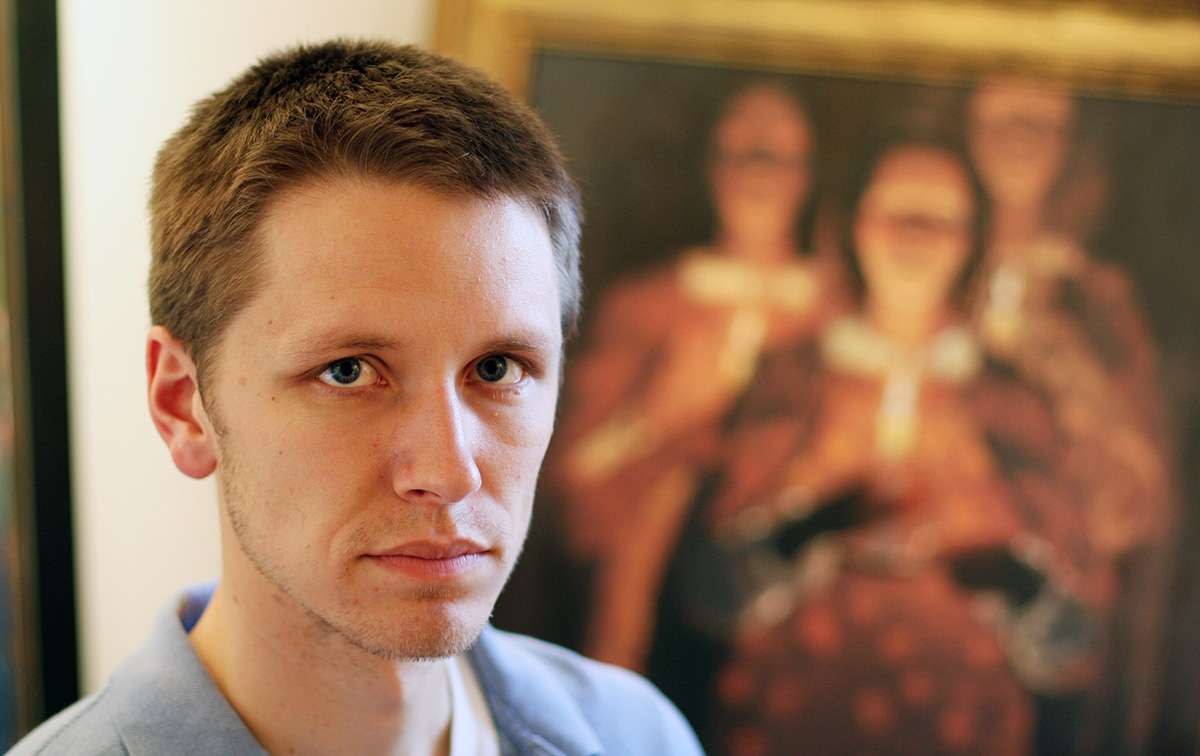
You do a lot of things—painting, music, videos, children’s books. How did it all start for you?
I think everything started with music. As a child, I was raised on music. I took piano lessons and French horn lessons for years and years, so that’s where I learned discipline for one thing, but also an appreciation for the arts. Incidentally, my French horn lessons were at the fine arts center at BYU, so I would go to my lesson there and walk past the paintings that were on display and just really got excited about art.
With art, how did you start?
Like many creative kids, I used to draw as a child. Then as a young teenager I saw the movie Dead Poets Society and decided that I didn’t want to do music anymore. I stomped up to my parents and demanded that they let me quit music lessons. They were really wise and encouraged me to continue, saying that if I felt the same way after a year, they’d let me stop music lessons. So I did, and a year later, I felt the same way, and I ended up swapping—I convinced them to let me stop music lessons in exchange for art lessons. So, from about the age of 14, I had a private art teacher and was also taking art classes at school.
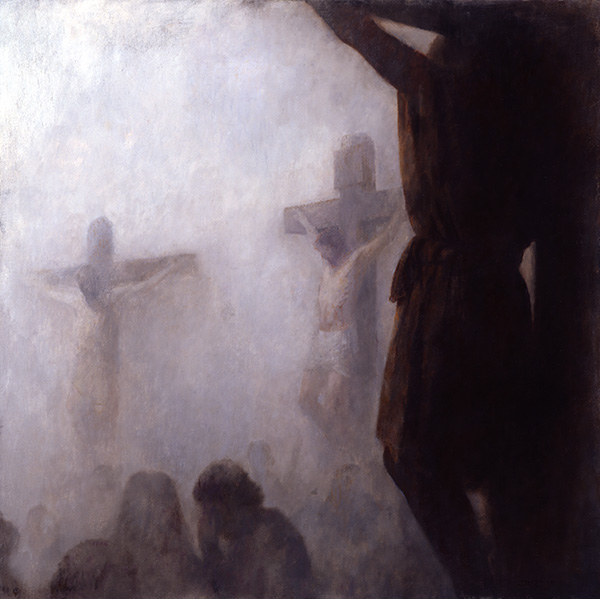
How soon did you realize you loved painting?
I’ve always had a love for it. But I wasn’t really committed to it as a profession until my first year at BYU. I was a freshman there, determined to study something more practical—in fact, I took Statistics 222H, which for an artist has absolutely no value. But I took a figure drawing class towards the end of my freshman year from Hagen Haltern, and I loved it, and pretty much from that point I knew that that was what I was going to need to pursue.
Did you continue taking art classes at BYU? Was that your major?
I did. I don’t think I declared one, but I was thinking about studying something in the sciences, and then by the end of my freshman year I was determined to be an artist, so pretty much from the end of my freshman year on, that was my major.
You served in Rome, right? How did your mission affect your growth as an artist?
My mission totally affected my artwork—anybody who’s been to Rome and Italy knows how much art there is, I mean, it’s just overflowing with art. You get off the plane and practically every corner you turn, you’re bumping into sculptures and statues. During preparation days, we’d go to museums like the Vatican Museum in Rome, and some of the great churches that have amazing paintings—like Caravaggio paintings—but even in the smaller towns, there was a culture of art which affected my painting. Also, I think the colors in Italy are reflected a lot in my paintings—the rust browns and a lot of the color choices I use, the muted palette and the color harmonies come from Italian architecture.
One other thing: the Italians have always loved the human figure, so even in the modern era, when New York took over from Paris as the center of the art world, and the great American painters were doing very abstract things, all through that time, even through today, Italians have had a continual history of using the human figure in their artwork. That’s something I love about the Italians and their artwork.
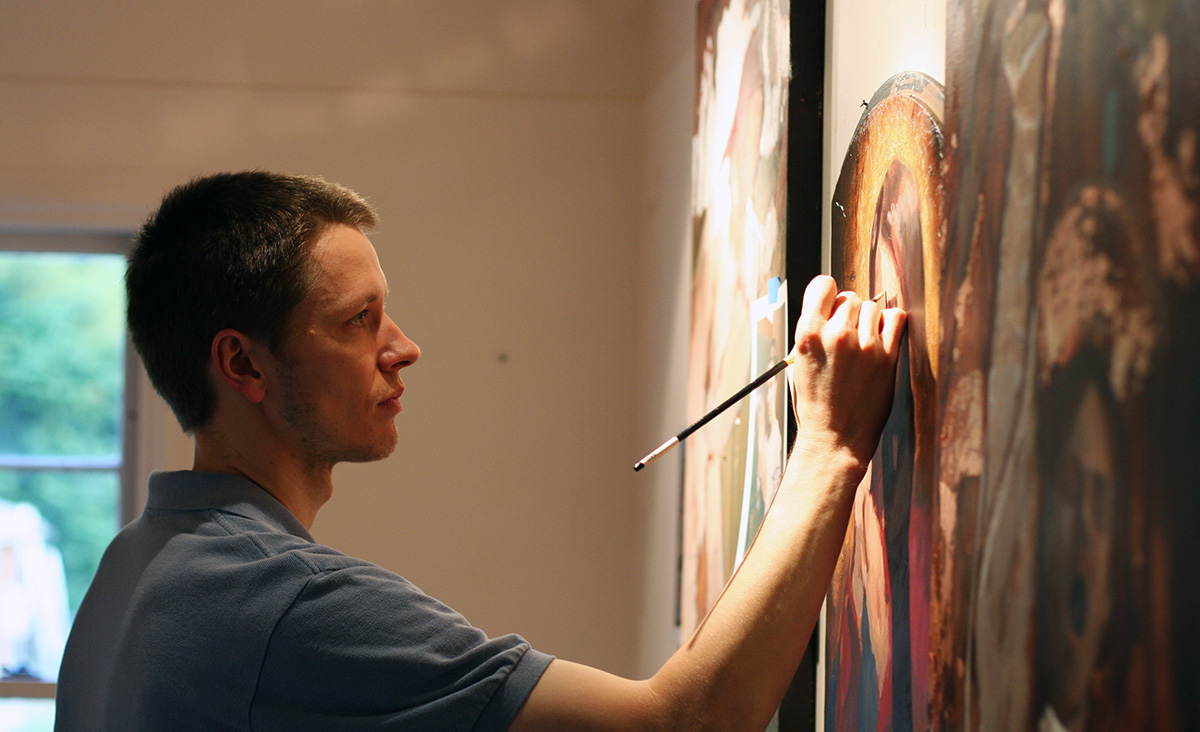
When you got back off your mission, you finished your degree. What happened after you graduated?
I was married two semesters before I graduated. I had sold a few paintings, and then I accepted a job to illustrate a book, The Carpenter of Galilee and the Welcoming Door, by Kenny Kemp. That was a big project for me—I think there were 26 paintings in that book—and I was simultaneously doing my own paintings. I don’t know how many I did that year, but it became pretty apparent to me that I liked to do my own thing, and that it would probably pay better than illustrating a book—my training wasn’t really in illustration. I knew that I just needed to paint the paintings and images that I had in my head and my heart.
What’s your experience been with making ends meet and making it work financially? What kind of obstacles have you run into?
The biggest obstacle, especially initially, is just believing that somebody’s going to buy these paintings. It’s a leap of faith, not knowing where they’re going. And then, of course, having the funds, because it costs a lot to make art. And if you’re going to do your own promotions, you’ve got to pay for that. We tried to keep our expenses extremely low at the beginning. It takes a little while to develop both your style and to figure out exactly where you want to go, and so it’s a good idea to not be paying a lot of unnecessary overhead at the beginning.
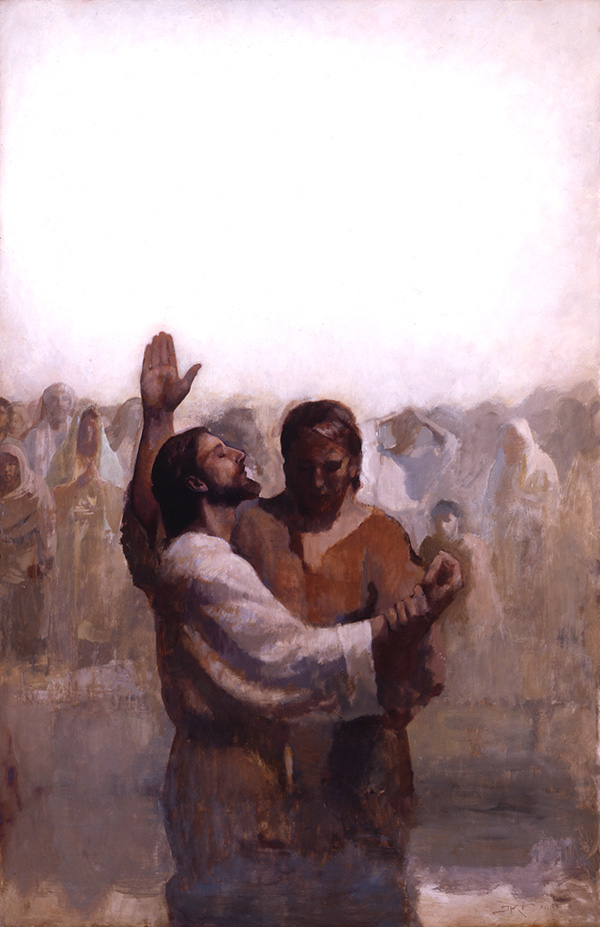
What’s a typical day like for you?
I used to sleep in till ten o’clock, but now I have an assistant who comes at eight o’clock every morning, which is early for me. I don’t set specific hours of the day aside for anything in particular—I usually try to just schedule the week and make sure I get certain things done. I’ll spend anywhere from zero to eight hours a day painting; it depends on how much other work I have, other projects I’m working on.
I spend a lot of time painting, finishing frames, installing paintings, getting images to magazines or putting them on the website. We’ve been doing some video and music and things that give me a break from art—interests I have that I like to learn about and pursue.
I often work at home. We just purchased a studio space down in Redmond, which is a suburb of Salina, and once a week I go down there for a day or two. It’s pretty big—it used to be a salt packaging facility—and some of the walls are pretty high, almost 17 feet, so I can spread out and work on big projects down there without any distractions, then come back here and get things done in between family obligations.
How do you balance family obligations with your art?
Sometimes it’s hard, because my brain is always in this creative world. It’s easy for me to not pay attention to what my kids are telling me or wanting me to look at or whatever they’re doing, but we do what most Church members do—family home evening, we try to eat dinner together, I often put the kids to bed, we often do it together. Every once in a while we take the kids out on one-on-date dates with a parent, and I try to go on dates with my wife. Actually, I do a lot with my wife. She helps with the business a lot, so we are often together all day, except when I go down to the studio, and she’s an artist, too, so I work with her and help her develop her interests.
How many projects do you do at a time?
I probably have 40 paintings in progress. Some of them move a lot faster than others—some are large, some are small. I’ve been consistently finishing about 25 paintings a year, but I’m trying to finish 40 this year.
Are those commissioned, or are they your own thing?
People who commission me know what I’m known for, so even commissions these days are usually along the lines of what you’d expect me to want to do in the first place, so that’s not a big issue. But I would say about thirty percent of what I do is commissioned work, and the rest are spec paintings that are either selling out of the studio here or going to galleries.
What’s your work process, taking a painting from start to finish?
I usually start with a sketch, a little thumbnail in my sketchbook that kind of looks like a doodle, maybe three by four inches or something. I usually jump right to the painting from that; I don’t do a lot of studies in between. I grid out the sketch fullscale and transfer it onto the canvas or the panel, then jump right into painting. I rarely use a live person, but sometimes I’ll bring my wife in, have her hold her hand in a certain position or something, taking photos for specific information I need to put in the painting along the way. That’s really it. And then I just try to finish it off the best I can.
There are some variations to that. Sometimes I won’t even do a sketch, I’ll just start with a panel and start throwing textures and color on it and build up layers and see what happens. Other times—rarely—I do a more thorough process where I start with a sketch, make the sketch bigger, try to fill in more details, and then do that a couple times before I go to a full-size painting.
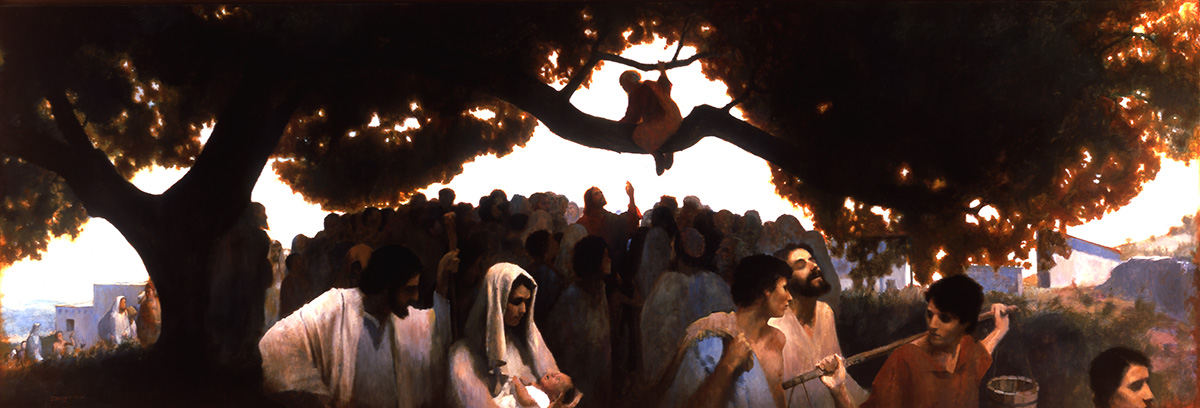
Is it always easy to start painting, or is it sometimes harder to motivate yourself to stir up the passion?
If there’s anything else that you need to do, that’s easier than getting down to painting. Getting ready—making sure you’ve got the right paints on your palette and your brushes are ready and your reference is ready—there’s a whole setup before you even start. And then it just takes a lot of energy, so when there are other things to do, it’s easy to put it off. A lot of my best painting is done at night after the kids go to bed and I don’t have distractions, when my day isn’t fragmented. I don’t know that there’s anything specific I do, except that it helps me to have music going while I’m painting. And I’m so deadline-driven these days that I just have to get down to it.
Speaking of music, what music do you listen to?
I was raised on classical, of course, but I love rock music, so I usually listen to some sort of rock. If I’m sitting in a chair looking at paintings, I’m likely to just fall asleep in the chair, so it does keep me awake. And it keeps my mind busy enough to not be tormented by the visual problems I’m trying to solve, but it leaves enough room for me to be thinking about how to solve them.
Could you expand on that a little more?
For example, I like to have some areas that are realist and finished while other areas are abstract. One problem will be, how am I going to leave some things abstract but have them still make sense in the painting? How am I going to finish some things off in a realist way but not take them too far? How am I going to make the eye move through the composition the way it needs to? Am I going to put colors here that relate to each other? Are my values working? Does something stick out too far? Does something not stick out far enough? And does it stick out too far in bright lights but not in dark lights? So those are all things you’re trying to resolve simultaneously, not to mention the structure—is her arm in the wrong place? Is her hand way too small? Is the gesture impossible or grotesque? Things like that.
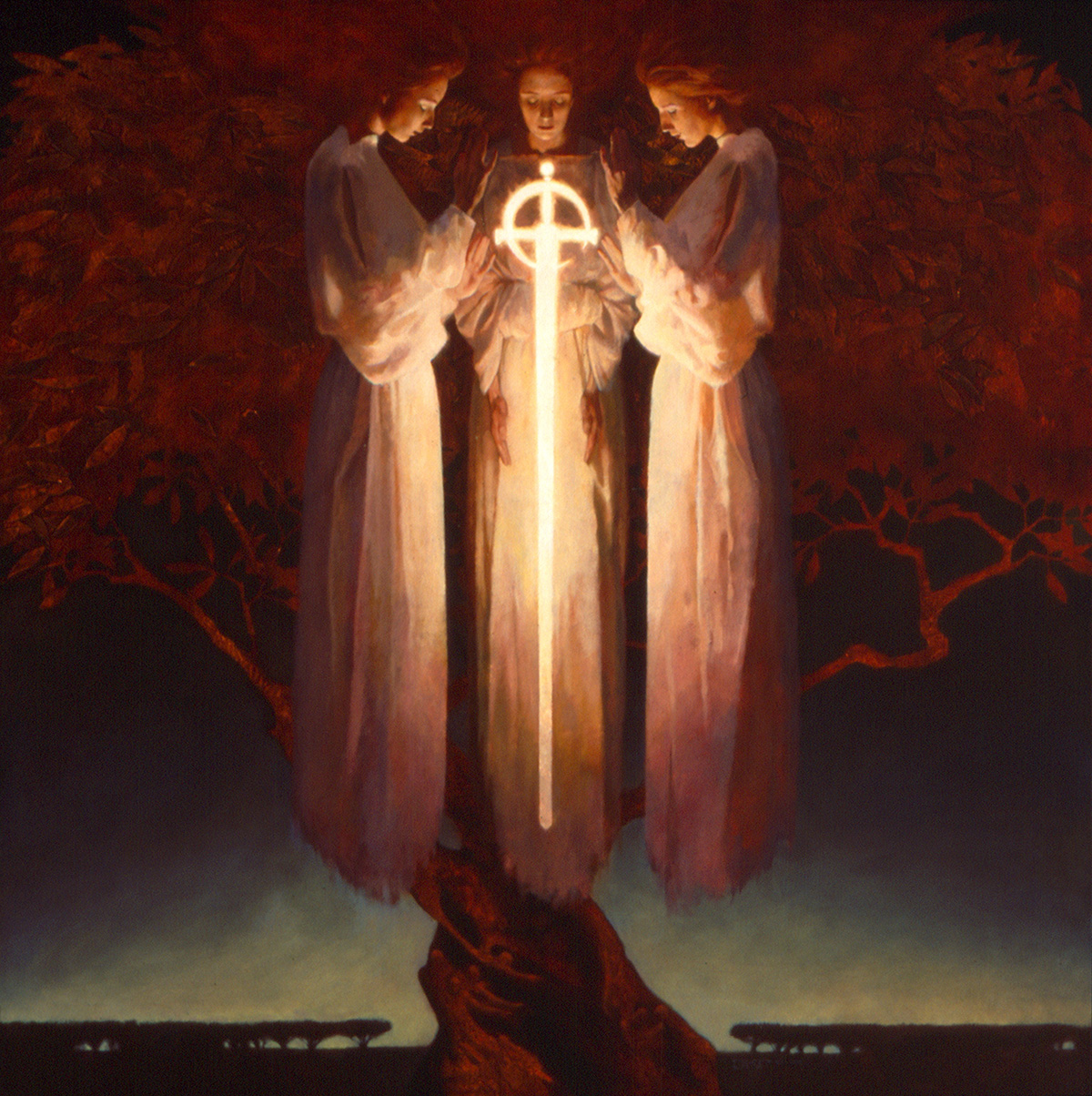
How did “Cherubim and a Flaming Sword” come about?
One of the things I love is a narrative as it relates to the painting—a painting that brings in a narrative in the context in which the painting is understood, or a point of departure that could fill a painting with meaning. The scriptures have always been one of my greatest sources of inspiration, and “the cherubim and a flaming sword” was a phrase that I loved. It brought feeling to me—the idea of cherubim and a flaming sword and the whole story of Adam and Eve, and these angels that were placed to guard the tree of life—and I wanted to capture that feeling visually. It was kind of a combination of beauty and power and mysticism, and these were all feelings that I wanted to put in this painting.
I have a few sketches I did which look nothing like the painting, and then I started the painting. I was painting these leaves, three-dimensional and floating around these angels, and it just wasn’t working. Then I went back and sanded it down and did a flat leafy pattern, which ended up working out nicely.
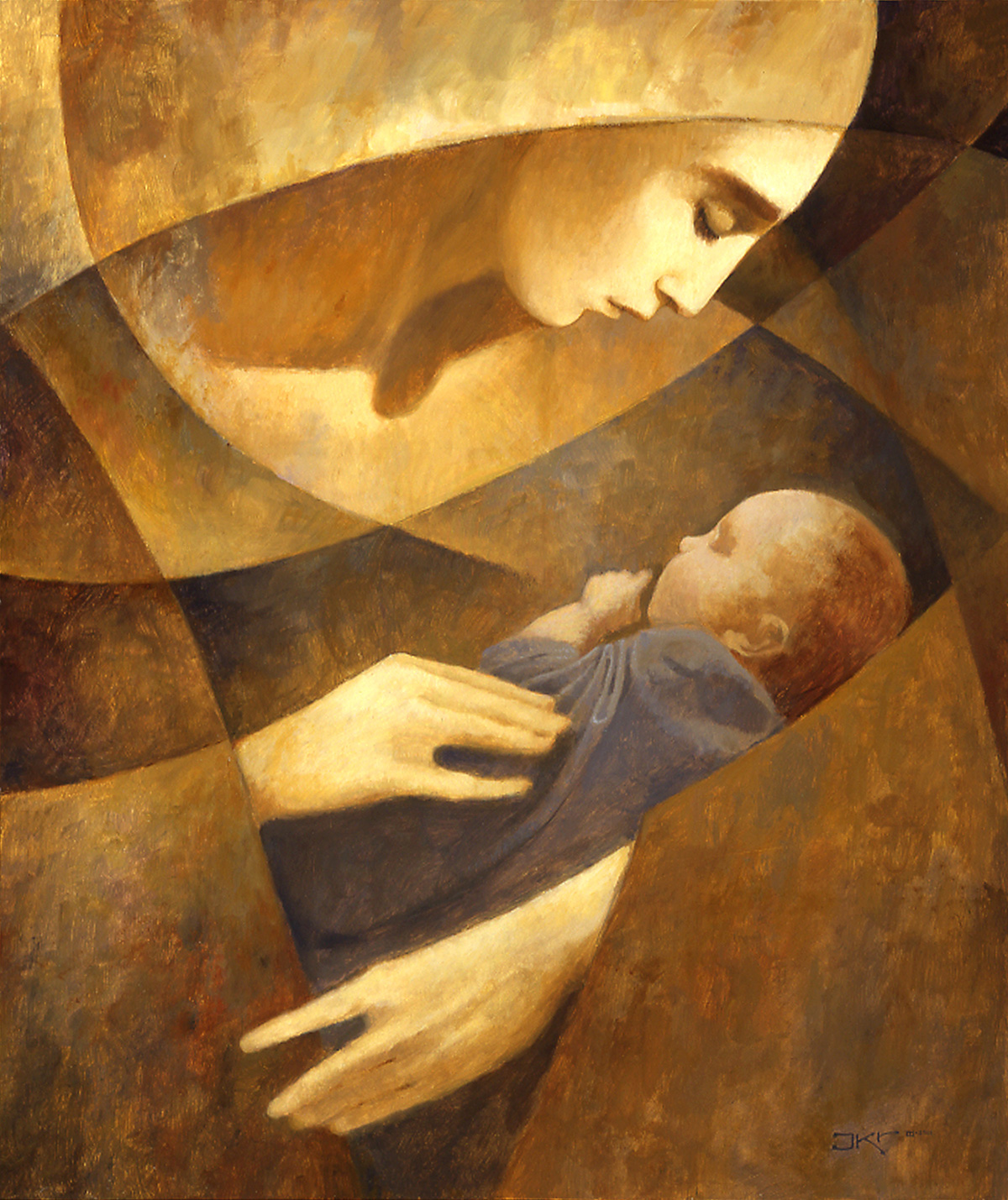
How did “Mother and Child” start?
When I was a teenager, my teacher, Clayton Williams, had me doing these little exercises—they were basically pencil shading exercises where we did these sweeping shapes that I filled in. I thought they were beautiful designs just as little pencil studies, but I wanted to make a painting, and so I did these same sweeping designs around a mother and child. That’s how it came to be, about the same time as the other painting.
You do a lot of religious, Judeo-Christian themed artwork. Why that as opposed to whatever else you could have done?
I’ve always loved the paintings of Carl Bloch, and there were some other artists I loved that had Christian themes. And in Rome the artwork is very much church-related. Every once in a while somebody asks me if I do it because I believe it or if I do it for money. I certainly do it because I believe it and because I love the narrative. I love the principles that Jesus Christ taught. I love the feeling of those paintings of Christ—all through time there are paintings that move me, though of course there are paintings of Christ that don’t move me.
I could probably do much better financially if I would abandon the religious themes. There are lots of galleries that would show my work if it wasn’t religious. Almost all of the major galleries want to remain secular to some degree, and so I’ve had galleries say, “Yeah, I’d love to show your work if you can give me a bunch of paintings that aren’t religious.” And the relationship usually ends there.
How does the gospel influence you both in your art, content and theme-wise, and as an artist?
Well, it’s provided most of my themes, or at least a point of reference. It’s also provided a place where I can make those paintings that I love and do it for a living—a unique place, actually, in terms of being able to paint Christ and have it provide for my family. We have the Springville Art Museum, and they even have a show dedicated to religious artwork every fall. The Church Museum has a competition they sponsor regularly. The Church magazines are always looking for great artwork to use.
I don’t necessarily paint specifically for any of these places; a lot of my work is not meant for Church magazines, because it’s not strictly didactic. There’s a symbolist aspect—people have to read beyond the literal things that I put in, like wings and halos, and see the symbol behind it in order to understand them—and the magazines are specifically designed to focus on doctrine.
The gospel has definitely provided subject matter, a point of reference, and a community that allows me to do what I like to do.
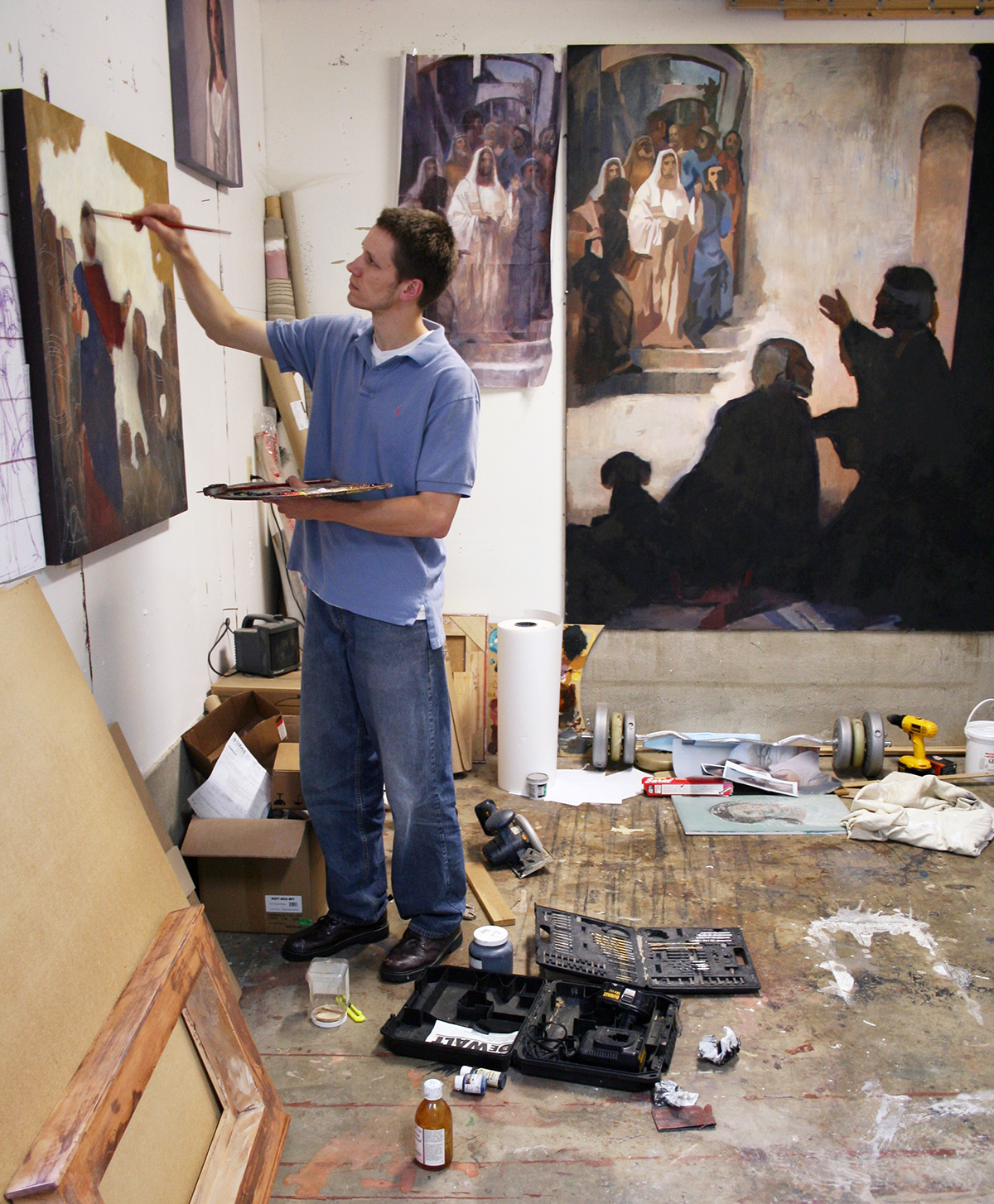
What is it like painting Christ?
I respond to classical, idealized imagery of Christ. And so I try to do that in my own paintings, which means not relying too much on visual reference material. A lot of artists will find a model they like who represents what Christ would look like to them. I’ve tried to avoid that. I do use photos to get light and a little bit of structure, but then I try to feel my way through the rest and put some of the characteristics that I feel are representative of Christ into the painting, in the image. I also love the feeling of antiquity—I love the feeling that this painting represents someone who has been the Lord since the beginning of time. A lot of paintings have textures and glows to them, a spiritual quality to them, if that’s possible in a painting.
I try not to make him look like he’s Scandinavian or from backwoods America, like a fur trapper or something. I have Christ paintings I’ve done that I still like, and there are some I can hardly stand to look at. It’s not an easy thing. Hopefully if I keep trying, by the time I die I will have done something lasting.
Earlier you mentioned mysticism. How do you see it influencing your work?
A lot of people don’t like it. I’ve heard people talk about mysticism as though it were in opposition to the clarity of the gospel. But for me, not everything is crystal clear. I have a lot of questions, which I think is part of growing—Joseph Smith went out and prayed and got an answer, and he and all the prophets and the scriptures have encouraged us to do the same thing. So it’s not like we have every answer; we’re encouraged to search.
That said, I just think there is something magical—if I can say magical, which kind of goes with mystical—about the whole concept that the gospel’s built on: the Atonement. We can get a glimpse, but as much as we try to understand it, there’s still something beyond our comprehension. And the power of God—I know it exists, I don’t know how exactly it works, but I know that it’s real. There is beauty in some of the romantic narratives surrounding the gospel, too, and I think they’re great for paintings. Every once in a while there’s a little bit of a grey area between what’s literal and what’s figurative. Even in the footnotes in the scriptures you’ll sometimes see the word “superstition.”
For example, this man was sitting at the pool of Bethesda, waiting for the moving of the water, because the first person to touch the pool after an angel supposedly touched it would be healed. Would God really send an angel to disturb this water every now and then so that one person out of this crowd who’s waiting could be healed? I don’t know. Maybe he would, but regardless, it’s a romantic idea, and I think it’s beautiful and has merit whether or not we interpret it literally.
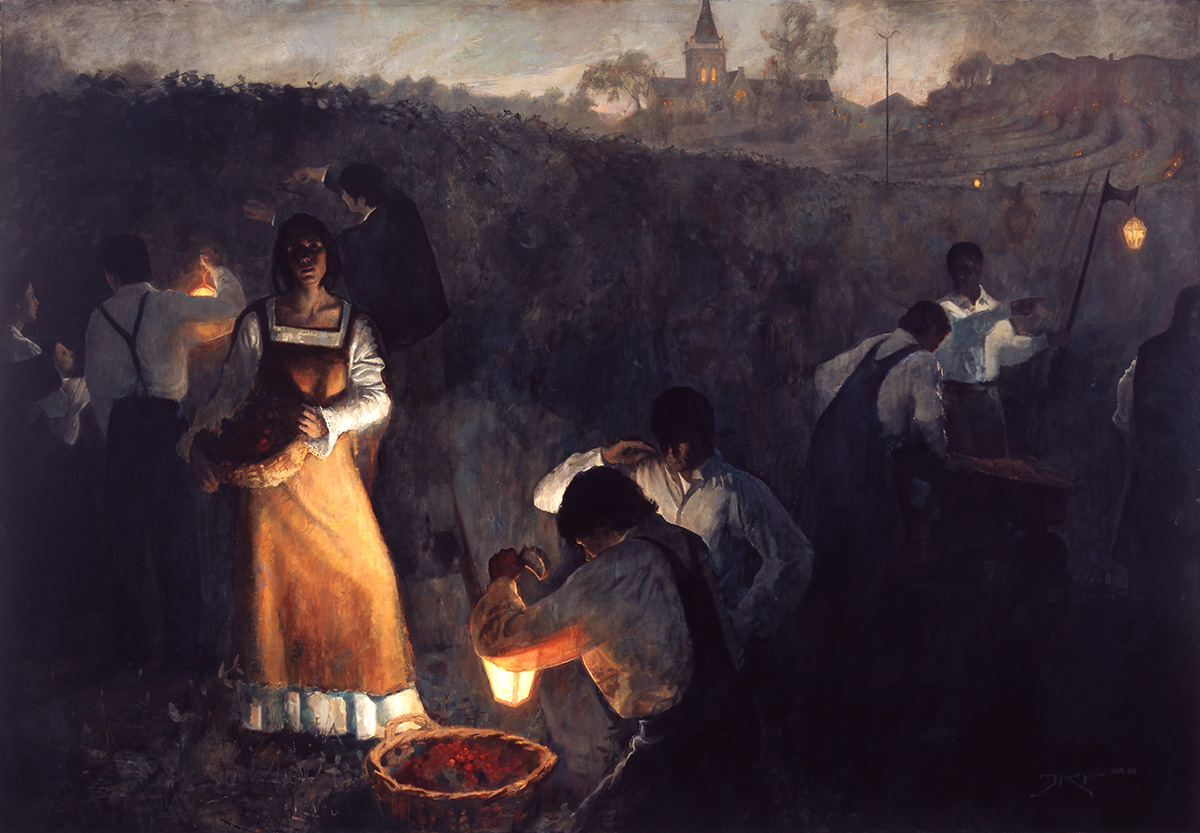
You mentioned some of the symbolic aspects of your work. Do you consciously decide to plan them in, or do they just come about as you’re painting?
It works both ways. Sometimes I’ll have an idea, I’ll think, “It would be great to do this, and then it’ll represent this,” but then it’s not working as an image, so I have to make changes. And then I think, “Well, that’ll mess up my metaphor.” Oftentimes it’s a compromise and I have to exchange metaphors in order to make a good picture. So the meaning of the painting at the end may not necessarily be what I anticipated at the beginning.
How did you get started with I’ll Be There With Belzon and your other children’s books?
My wife likes plays on words; she’s always mixing words up in her head, and so she and her companion in the mission field—she went to Norway—always joked about this character, Belzon, who would follow them around. They’d say they’d be there with Belzon.
So I started working on that book even before I finished Ken’s book. I liked separating the two worlds, this spiritual fine art world and the book world. It was mixed in Ken’s book, and I wanted to separate them—and to work in colors I would never use in a painting. That Belzon book is pretty much all blue.
It took me a few years to get that book finished, because I didn’t want to take it all the way myself. I wanted to hand it over to a publisher, so I sent it out to many publishers and got quite a good response. I heard immediately back from the lady who’s been doing all the Lemony Snicket books, the editor at HarperCollins, and we talked for a while. She loved the images but just wasn’t quite as keen on the story.
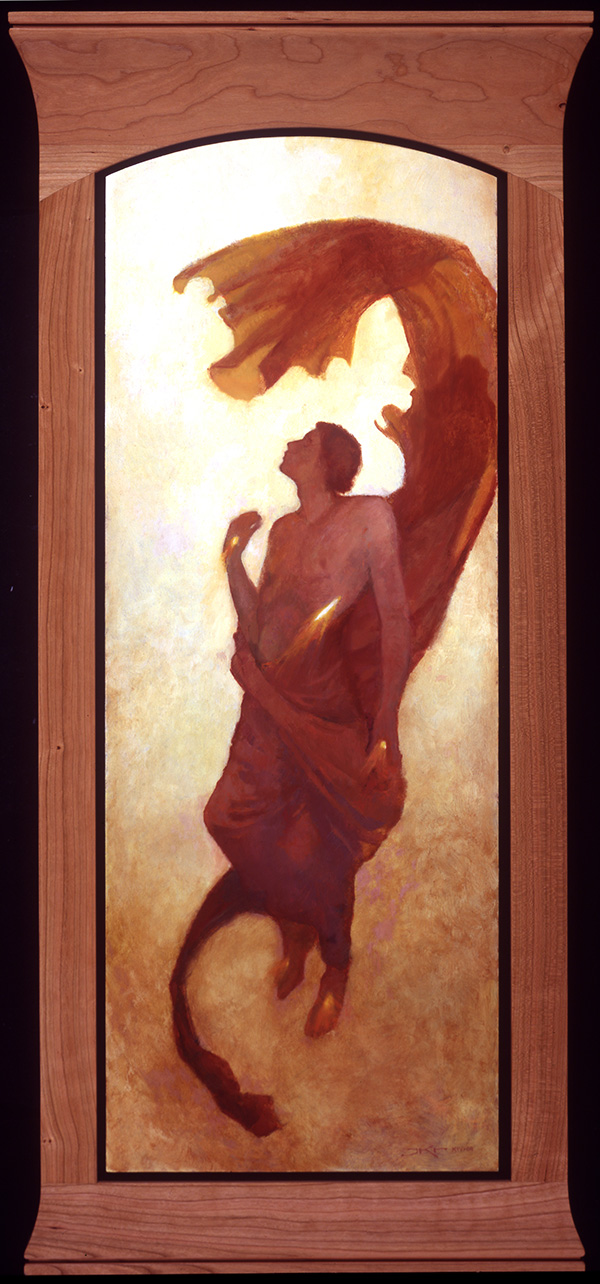
We ended up printing it ourselves and getting it out there. We’ve sold quite a few copies, but it’s still a hobby for me.
I do school visits. I’ve done some here locally and some in California and Tennessee, where the school has me come in and read to the kids. It’s a lot of fun. The kids are so smart, and they pick up on things you can hardly imagine, things that I didn’t even notice or read into in my own books.
You’ve recorded some music as well. How did that your album Granted start?
We actually started it here right before we moved to Nashville, then we really got into it in Nashville. I’ve always wanted to record, and I’m about to finish a second recording project that I’ve been working on for maybe five years, Somewhere Along the Line. And you know, this process continues to elude me. But I love it, and I think that some of the new songs are closer to a sound that I’m happy with. I love lyrics, and I love music, and I love the process of engineering sound. It’s a very different area of art, although there are many things that are similar or parallel. But I hope maybe further down the road, I’ll really get something magical. It’s something that is still quite a learning process for me right now.
And you’ve done music videos.
I love working with rhythm and flow and all of the wonderful things that you think about in poetry and song lyrics. To add visuals and to play with those aspects in a visual medium is just really amazing. With a painting, you have rhythm and motion, but it doesn’t move through time. The great thing about video is that it moves through time.
What are your favorite and least favorite parts of life as an artist?
I love to start a new painting. And I love to finish it. It’s all that work in the middle that I don’t love as much… I love to start new creative projects, and I could do that all day long. There’s so much work involved, and sometimes I love it, but sometimes it’s just work that you’ve got to get through. I love that people respond to the work—I love hearing that it has really made a difference for somebody, or that it’s really struck a chord with them. I love being at home. I love not having a boss—I’m an independent person that way.
The things that I don’t like are sometimes having to let go of a painting before I’ve completely resolved everything. I hate not being able to love my finished product. My consolation there is that even Leonardo da Vinci did some pretty bad paintings, and yet the Mona Lisa’s arguably the most famous painting in the world. And then of course there’s always financial stresses.
There’s much more that I love about it than I don’t like, and that’s why I’m an artist. And I wouldn’t trade it.
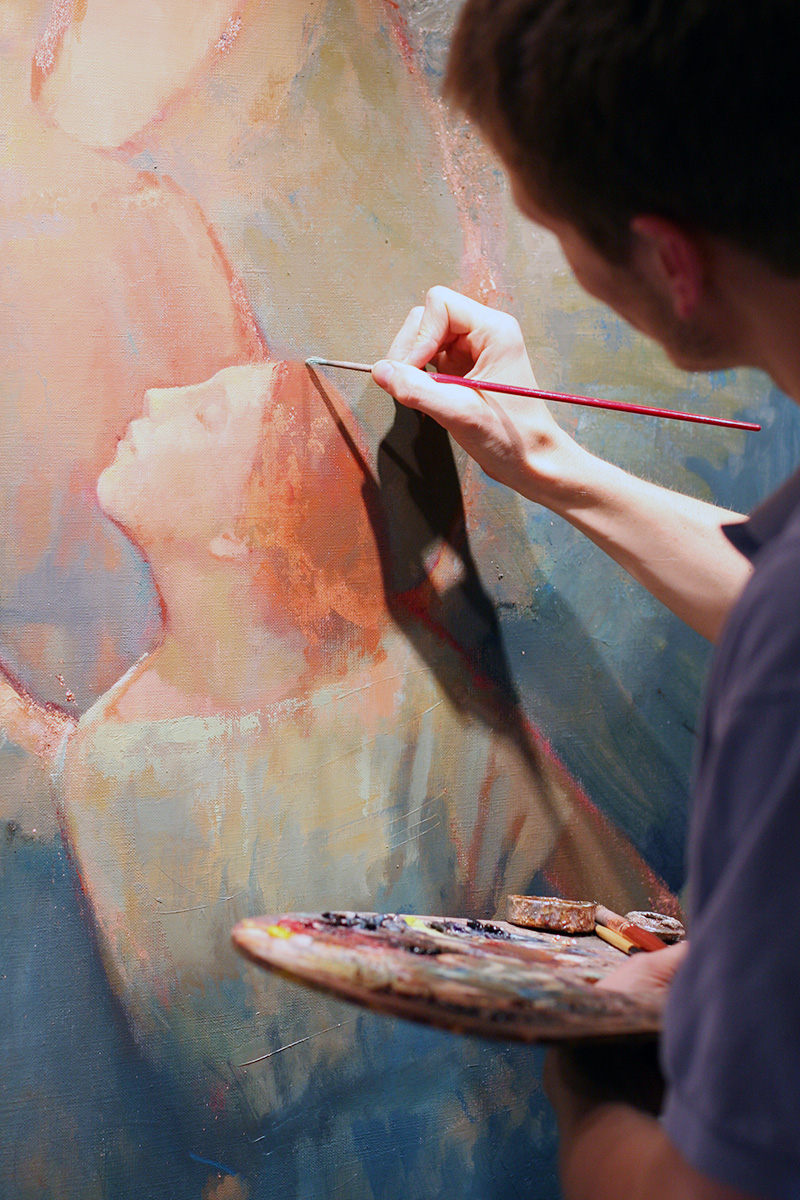
With your paintings, who do you see as your audience? Mormons only, or Christians in general?
Definitely Christians. I’ve done a few LDS-specific paintings, but I haven’t done a lot—partly because I like the timelessness of Christ imagery and angels and things like that. I don’t want to pin my paintings down to a representation of the late 1800s or the 20th century. I do have an audience that hopefully is LDS and non-LDS Christians and even beyond—you know, I hope somebody can look at the “Cherubim and a Flaming Sword,” and whether they be Buddhist or Jewish or atheist, feel kind of drawn into it, and be kind of moved and curious about it.
If you could have lunch with anyone, who and why?
One of my last days in the mission field, I tracted down Ennio Morricone. He’s the composer of the soundtrack to The Mission. I left a note with his doorman, and he wrote me back. But I can’t find that letter anywhere. ❧
